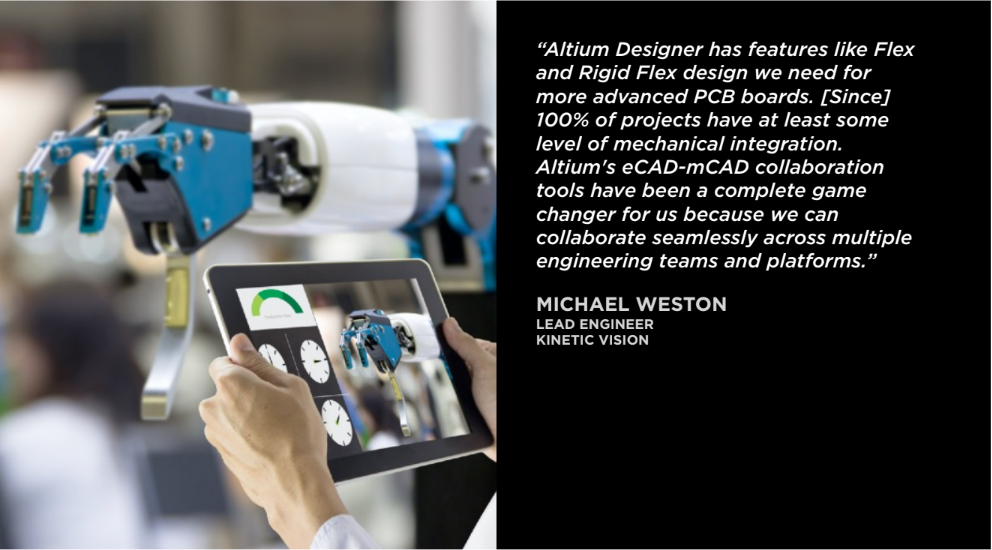Smart PCB Design Solutions With Kinetic Vision and Altium 365

All smart devices start with great ideas, but to go from a concept to product takes more than just innovation—it takes a team of experts from printed circuit board (PCB) designers to machine learning specialists. This array of expertise is a challenge to find under only one roof.
Kinetic Vision, a Cincinnati-based design, engineering, and development firm, is an innovator’s one-stop-shop for transforming even the wildest ideas into real products. Among their diverse client list are 50 of the Fortune 500 and 15 of the Fortune 100 companies.
The company’s one-stop-shop approach keeps everything in-house, including PCB design solutions, industrial design, mechanical and electrical design and engineering, hardware and software development, machine learning, visual communication media, prototyping, and sometimes even short-run production.

To best support production of smart products that incorporate electronics, PCBs, and communications chipsets, Kinetic Vision uses cutting-edge digital technologies and state-of-the-art hardware. Finding the right PCB design solutions, however, has been somewhat of a challenge for them over the years—that is, until they made the switch to Altium software.
In Altium Designer®, Kinetic Vision found a PCB design solution for all of their projects, from their simplest to their most advanced. As Michael Weston, Lead Engineer in Kinetic Vision’s Product Design and Development Group, explains, “Altium Designer’s 3D visualization, multi-user collaboration, and export standardization are essential for our work here at Kinetic Vision. Altium Designer has features like flex and rigid-flex design we need for more advanced PCB boards. Our medical space customers use these types of boards, more and more—having a tool in-house that supports them has been fantastic.”
In January 2020, Kinetic Vision moved over to the cloud-based Altium 365, just a few weeks before the COVID-19 crisis began sweeping the United States. “We switched over to Altium 365™ in January 2020 because we needed a more stable platform for our data and collaboration methods compared to the local methods we were using, but with the COVID-19 situation, the platform became even more essential because our team members could continue to work remotely. Altium 365 has given us more power to create brilliant work—no matter where our team is working from,” Weston adds.

Exponentially Improving Process Flow
Kinetic Vision understands that creating "smart" devices requires a team of specialized experts, each bringing their unique expertise to the table to create truly innovative products.
Altium Designer gives their diverse team all of the tools they need while empowering effortless workflow across multiple departments. As Weston explains, "We collaborate a lot here at Kinetic Vision; 100% of projects have at least some level of mechanical integration. Altium's ECAD/MCAD collaboration tools have been a complete game-changer for us because we can collaborate seamlessly across multiple engineering teams and platforms."
In the weeks leading up to the COVID-19 lockdowns, Altium 365 adoption was already spreading throughout Kinetic Vision. While the tool was originally purchased for the Product Design group, Weston soon found it in use everywhere.
“We have firmware developers, system engineers, project managers and mechanical engineers using Altium 365 as a viewer/markup tool for hardware designs. The mCAD collaboration tools and 3D visualization tools are invaluable when integrating with other teams. The systems we used previously required us to spend extra time and effort to visually align the components as we moved from mechanical to electronic CAD. Altium 365’s unbeatable visualization tools give us a true experiential vision for workflow,” Weston adds.
Where stay-in-place orders have slowed some businesses down, with Altium 365, Weston’s team has managed to improve their workflow processes. “Altium’s visualization and collaboration tools have improved our process flow by a factor of five. It has enabled a truly remarkable improvement in our productivity,” Weston concludes.
